The Good, the Bad and the Odd: A Cross-Semiotic and Systemic-Functional Insight into "Twin Peaks"
Abstract
A paradigmatic series, widely acclaimed as the major TV drama product of the 1990s and the prototype of today’s multimedia storytelling, Twin Peaks’ first two seasons were aired on ABC between April 1990 and June 1991. From a narratological point of view, the recipe of Lynch and Frost’s product may be summed up as a structural, generic and transmedia mix of contrasting elements. On the one hand, viewers are presented with an extremely convoluted plot structure, made up of extended, intertwining subplots, drawing from both classical detective and mystery fiction and supernatural, horror, fantasy and doppelgänger literature, which both stimulate and challenge their narrative literacy. On the other hand, they are exposed to an uncanny, grotesque narrative pitch, one that brings together the bizarre, mephistophelean atmosphere of a Fuseli-meets-Jung narrative and visual situation with a self-consciously melodramatic overtone, borrowed (perhaps parodied) from the golden age of US soap operas. The equator of such complex coordinates is however the concept of oddity in its multiple manifestations, such as weirdness, incongruity, eeriness, grotesqueness, dysfunctionality, quirkiness, absurdity, improbability and plain logical impossibility. It is indeed hard to decide whether the series is more disquieting or hilarious. This paper aims at disassembling the mechanics of oddity of Twin Peaks, by means of a multidisciplinary methodological framework which incorporates narratology, cross-semiotic analysis and Systemic Functional Grammar. A series of dichotomies within the show’s structure will be explored, i.e. visuality vs. narrativity, spatiality vs. temporality, materiality vs. processuality, perceptual vocabulary vs. structural syntax, in order to analyse how oddity takes shape and place in the show. The interpenetrating complexities of space and time, ultimately embodied in FBI Agent Dale Cooper’s mystic philosophy, are foregrounded against a humorously overcontrived mixture of contrasting genres and media, including cinema (both including and other than the Lynch filmography), TV, literature, the visual arts, and music, which interact – interfere? – with one another in the making of Twin Peaks’ surreal narrative universe. Twin Peaks’ powerful Aristotelean drive, with its emphasis on the narrative productivity of spectacularised bodies (remember the “wrapped-in-plastic” opening scene?) and praxis (“It is happening again”, as the Giant reveals in the Roadhouse dream sequence) embedded in a next-door, small-town, real-life America setting, thus seems to precisely dramatize the processual, translational spirit of today’s storytelling.

Downloads
Pubblicato
Come citare
Fascicolo
Sezione
Licenza
Copyright (c) 2023 Elephant & Castle

TQuesto lavoro è fornito con la licenza Creative Commons Attribuzione 4.0 Internazionale.





